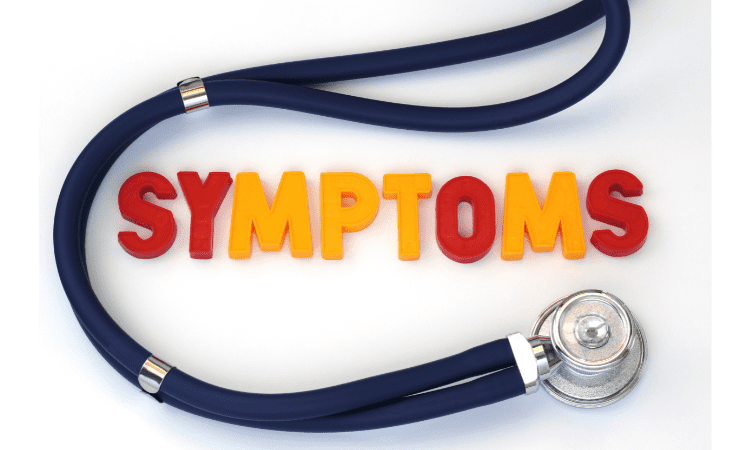
About one in 100 Americans have celiac disease, an autoimmune disorder that prevents the absorption of nutrients from food. But that number doesn’t include those who develop gluten intolerance without full-blown celiac disease. Gluten intolerance is often a silent condition because its symptoms are similar to those of other health problems. And since gluten is found in so many foods and food additives, there’s no easy way to tell if you’re sensitive without testing yourself — especially if you’ve eaten products containing wheat for years or decades.
That’s why it’s important to be aware of some of the hidden symptoms of gluten intolerance so you can better understand how your body responds to certain foods instead of just guessing what might be wrong when you have unexplained symptoms like fatigue or belly bloat after meals.” Lets find out signs of gluten intolerance in early stage to avoid problems.
What is gluten intolerance

Gluten intolerance is a condition in which the body cannot properly digest gluten, a protein found in foods such as bread and pasta. Gluten intolerance can cause a variety of indications, ranging from fatigue to gastrointestinal distress to joint pain. If you suspect that you have gluten intolerance, consult your doctor for a diagnosis and treatment plan.
If you’ve been diagnosed with celiac disease or if you’ve experienced any signs of gluten intolerance (such as chronic diarrhea), it’s important to change your diet drastically—and permanently—so that your body doesn’t become dependent on food products that contain gluten. Many people who suffer from celiac disease experience lingering effects even after they adopt a strict gluten-free diet; these lingering effects may be caused by long-term damage done by eating foods containing high levels of gluten over many years before being diagnosed with celiac disease or experiencing other symptoms of gluten intolerance.
How can people identify gluten intolerance?
Gluten intolerance is not a well-understood condition, and many people do not know that they have it.
The most common symptoms are bloating, gas, abdominal pain, diarrhea or constipation, headaches, joint pain and muscle weakness. The symptoms can be very similar to other digestive disorders and may be easily overlooked as a result. Because of this, it is important for people to be aware of their own symptoms and keep track of them over time so that they can identify patterns when they occur.
It can also be helpful to look at what you eat before you get sick. If you notice that certain foods consistently cause problems in your body then it could indicate food intolerance rather than gluten intolerance.
What are other conditions that people might confuse symptoms of gluten intolerance for?
There are a lot of conditions that people confuse symptoms of gluten intolerance with.
These include:
- -Irritable bowel syndrome (IBS)
- -Inflammatory bowel disease (IBD)
- -Sinus infections
- -Stomach ulcers
Can a gluten intolerance cause heart palpitations or increased heart rate? If so, how and why?
It’s true: you can have a gluten intolerance, and it can cause heart palpitations.
The reason is that gluten intolerances can cause inflammation throughout the body, which can then cause problems with your heartbeat. In fact, some people who have gluten intolerance may also have a condition called “atrial fibrillation,” which is a type of irregular heartbeat.
To treat heart palpitations caused by gluten intolerance, you should take steps to reduce inflammation in your body. You can do this by eating foods high in omega-3 fatty acids (like salmon), getting plenty of exercises, and avoiding stressors like caffeine and alcohol.
Signs and Symptoms of gluten intolerance

The key to avoiding the symptoms of gluten intolerance is to identify your triggers and avoid them. Some people are more sensitive than others, but all should try to avoid eating foods containing gluten as much as possible. If you notice that eating a certain food causes you discomfort, such as chronic bloating or diarrhea, try not eating it again for three weeks and see if your symptoms improve. If so, it’s likely that the food was causing you harm and should be avoided in the future.
Here are some common foods that contain gluten:
- Wheat (breads, pastas)
- Barley (beer)
- Rye (rye bread)
- Oats (oatmeal)
Recurring headaches and migraines

Most people think that headaches, migraines and other neurological problems are due to stress and not being able to sleep well. But these symptoms can also be hidden symptoms of gluten intolerance. Gluten intolerance can cause inflammation in the brain or spinal cord. If you have recurring headaches or migraines, or if your doctor has told you that your blood pressure is high, it’s important for you to get tested for gluten intolerance.
Diarrhea or constipation

Diarrhea, or loose stools, is one of the most common symptoms of gluten intolerance. It can affect you at any time of the day and can be accompanied by other symptoms such as gluten belly bloating, abdominal pain and nausea.
Constipation is one of the common signs of gluten intolerance. The condition may be characterized by infrequent bowel movements or hard stools that are difficult to pass through your rectum.
If you have experienced diarrhea or constipation on a regular basis for at least three months, talk to your doctor about how it could be related to your diet.
Abdominal pain due to gluten belly

Abdominal pain is a common symptom of gluten intolerance. This can include cramping, bloating, or fullness. The pain may be mild or severe and often worsens after eating foods containing gluten. People with celiac disease sometimes report that they have abdominal pain even when they aren’t experiencing digestive symptoms or have no other obvious signs of celiac disease (such as weight loss).
If you have abdominal pain that lasts for more than four hours at a time without any obvious cause like an infection or injury, see your doctor to rule out other health issues such as irritable bowel syndrome (IBS). You should also see your doctor if the pain becomes persistent despite changes in diet and lifestyle.
Nausea

If you’re experiencing nausea, it may be because of a food intolerance or other underlying condition. One of the most common causes is gluten belly bloat.
Nausea is a feeling that comes from your stomach and can range from mild discomfort to severe vomiting. It’s often accompanied by abdominal cramps and diarrhea, which can make you feel even worse if you have nausea as well.
If you experience nausea after eating something that doesn’t usually make you sick, then this could be a sign that there’s something wrong with your body—not necessarily just signs of gluten intolerance.
Gastrointestinal problems

Gastrointestinal problems, such as irritable bowel syndrome (IBS), celiac disease and inflammatory bowel disease (IBD) are some of the most common signs and symptoms of gluten intolerance.
Most people have some form of IBS in their lifetime. If you experience chronic abdominal pain or bloating with other digestive issues such as constipation or diarrhea, your symptoms may be related to an underlying problem like celiac disease or IBD.
If you have been diagnosed with IBD—which include ulcerative colitis, Crohn’s disease, microscopic colitis—you might also suffer from gluten intolerance if these diseases cause your body to attack itself due to genetic predisposition or autoimmune issues like Hashimoto’s thyroiditis.
Chronic fatigue and muscle aches
The primary hidden symptoms of gluten intolerance include a gluten belly bloat and chronic fatigue. These are due to inflammation in the gut and brain, which makes it difficult for your body to break down food efficiently. You may also experience muscle pain and aches as a result of this inflammation.
Fatigue is one of the most common symptoms of gluten intolerance, but one that remains under-diagnosed for many people who have it. If you’re feeling tired all the time without any apparent cause, there’s a good chance that your fatigue might be related to an inability to absorb nutrients from your food—a symptom caused by celiac disease or another form of gluten sensitivity/intolerance.
Depression

Depression is a common signs of gluten intolerance, and it’s not something to be ignored. You may feel like you’re getting depressed because of the foods you can’t eat or the social isolation that comes with avoiding gluten-containing products. However, depression is a real medical condition that can be treated just like any other illness. It’s important to seek help if you think that dealing with gluten intolerance is affecting your mental health in any way.
The good news is that there are medications available specifically for treating depression (called antidepressants), as well as therapies including talk therapy and cognitive behavioral therapy (CBT). These treatments won’t necessarily cure the underlying cause of your depression—it will take some time before any benefits from these methods begin to take effect—but they do provide relief from its symptoms until those underlying issues resolve themselves over time.
Skin problems

One of the most common symptoms associated with gluten intolerance is skin problems. Many people with gluten intolerance experience rashes, eczema, psoriasis and dermatitis. People suffering from these conditions may also suffer from acne or itchy skin.
Some people may notice dry or flaky skin that’s red in color; this can be caused by an allergic reaction to gluten or a sensitivity to dairy products (which often have a similar appearance). Hives are another popular symptom; swelling on your face or limbs can also occur if you have celiac disease—the most common type of gluten intolerance.
If you’ve ever had hives after eating bread products such as pizza crusts and bagels before being diagnosed with celiac disease then chances are good that you need to eliminate those foods from your diet altogether rather than simply avoiding them during times when they cause reactions like this one.
Mental fogginess

Mental fogginess is a symptom that can be caused by many conditions, including gluten sensitivity. If you have ever felt like your brain is in a fog and you can’t concentrate, this could be the signs of gluten intolerance or sensitivity.
Gluten intolerance typically causes mental fogginess as the first sign of its existence. The body’s immune system reacts to gluten as an invader, which in turn creates inflammation throughout the entire body and produces antibodies against it. These antibodies attack whatever tissue they come into contact with—including brain tissue! When this happens on a systematic level, it creates an inflammatory response that causes mental fogginess (and some other symptoms).
Diagnosis of autoimmune diseases
You may have heard that gluten intolerance is a digestive disorder, but this isn’t the only way it manifests. Gluten can also cause autoimmune diseases that attack different parts of the body. Some autoimmune disorders include celiac disease (damage to the small intestine), dermatitis herpetiformis (skin rashes), Hashimoto’s thyroiditis (underactive thyroid) and multiple sclerosis (nervous system).
Symptoms vary by disease: Multiple sclerosis can cause numbness in hands and feet; dermatitis herpetiformis results in painful skin sores; while Hashimoto’s thyroiditis leads to symptoms like fatigue, weight gain and depression. If you experience any of these symptoms or others associated with autoimmunity—including joint pain or swelling—you should consult your doctor immediately because they may indicate an autoimmune condition is present.
What foods are high in Gluten?

Wheat is the most common grain to be contaminated with gluten. It’s used in a wide variety of foods and can be found in breads, pastries, cookies, cakes, cereals and pasta.
Spelt might sound like it’s just an alternative to wheat but it also contains gluten and should be avoided by those with celiac disease or gluten intolerance.
Rye is another form of wheat that contains gluten so it should also be avoided if you have a gluten intolerance. Most people find they aren’t able to tolerate rye bread once their symptoms become severe enough for them to notice there’s something wrong!
Barley has been known as a staple food for humans for centuries but some people are unable to consume barley due to the presence of gluten within this grain product. Barley is often found as an ingredient in soups or stews since it adds flavour without being too overpowering like other legumes would be when added during cooking.
Gluten free food
The foods that are gluten free are:
- Meat, fish and seafood.
- Eggs
- Dairy products including milk, butter, cheese and yogurt.
- Fruits such as oranges, apples, bananas and pears (not processed fruit juices).
- Vegetables such as potatoes and green beans without sauce or dressing on them (try not to eat canned vegetables unless they are labeled as gluten-free).
- Legumes such as peas and beans that have been cooked in water until tender (you can also use canned lentils if you cook them on the stove top)
How Can Gluten Intolerance or Gluten Belly Bloat Be Treated?

- Increase intake of vitamins and minerals.
- Get tested for celiac disease.
- Take a gluten-free diet.
- Treat the symptoms.
- Consult to a doctor.
Aside from seeing a doctor, are there any tips to try at home, like keeping a food diary?

Yes, there are some tips you can try at home.
First, keep a food diary. Write down everything you eat and drink, including when and how much of it you consume. This will help you get a better idea of what foods are causing your symptoms. If you can’t associate any particular food with your symptoms, try keeping track of your symptom severity over the course of several days to see if there’s a pattern when it comes to timing—for example, if they tend to occur after eating dinner.
Second, try eliminating gluten from your diet for two weeks and then reintroduce it to see if symptoms return. You may also want to have blood tests done during this time period so that you can have an accurate baseline for comparison after reintroducing gluten.
Third, look for other sources of inflammation in your diet: dairy products and sugar can cause inflammation in the gut, which can lead to other gastrointestinal issues like bloating or gas.
Conclusion
In conclusion, it is important to remember that there are many hidden symptoms of gluten intolerance. These symptoms can be difficult to trace back to the cause, but if you experience any of these symptoms and suspect that they may be due to your diet then it is worth consulting a doctor or nutritionist for some professional advice.














